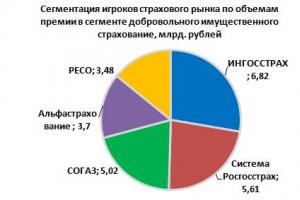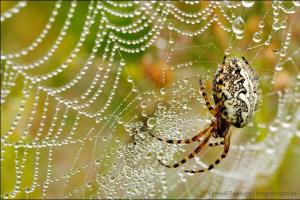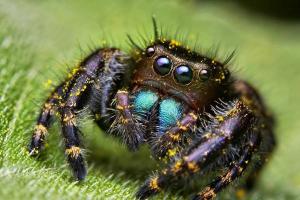The population of which is either falling at a rapid pace, or is improving, but is still catastrophically small.
Natural phenomena and human factors are among the main reasons for the decline in the numbers of some rare animals.
The rarest animals on Earth are included in the International Red Book.
Here is just a small part of these unique representatives of the animal world.
15
Rare animals of the world: Tarantula spider (Poecilotheria metallica)
In addition to being incredibly rare, this member of the animal kingdom is also one of the most beautiful tarantulas. This spider lives in the tropical forests of southwestern India, building houses high in the treetops. Younger representatives of this species live at the roots of the tree, where they can dig holes and weave thick webs around them. In case of danger, they hide in their holes.
14
Animals listed in the International Red Book: Madagascar beak-breasted turtle (Astrochelys yniphora)

© KatarinaGondova/Getty Images
This species of land turtle, also known as the angonoka, is critically endangered. Endemic to Madagascar, the IUCN Rare Species Commission has declared it one of the most “vulnerable” animal species on our planet. Today, Angonoku can be found in a small area in the north-west of the island of Madagascar. The density of these animals in nature does not exceed 5 individuals per square kilometer. In total there are 250-300 individuals per 100 square meters. km. In captivity you can find 50 representatives of this species.
13
Animals from the Red Book: Peters's proboscis blenny (Rhynchocyon petersi)

© ivkuzmin/Getty Images
This rare animal species is listed in the International Red Book as “at risk of becoming extinct.” Also known as the red-shouldered blenny, this mammal, a member of the jumping family, lives in Africa. The species received its name in honor of the German zoologist Wilhelm Peters. Peters's proboscis blenny can be found in the forests of southeastern Kenya and northeastern Tanzania.
12
Animals of the Red Book (photo): Angelfish (Squatina squatina)

© Placebo365 / Getty Images Pro
Listed as a Critically Endangered Species on the International Red List, the sea angelfish (also known as the European squatfish) can be found in the seas of the northeast Atlantic, namely in the hot and temperate zones. Representatives of this species of shark from the order Squatinidae are similar to stingrays due to their enlarged pectoral and ventral fins. They are most often found on the ocean floor and feed mainly on flounder fish.
11
Animals of the International Red List: Northern long-haired wombat (Lasiorhinus)

© manny87/Getty Images
Being on the verge of extinction, this wombat is considered one of the rarest animals on our planet. There are fewer of them on Earth than Sumatran tigers. There is only one extremely small population left in the Epping Forest National Park, which is located in the center of Queensland, Australia. Scientists believe that the reason for the decrease in the population of these animals is changes in their habitat. Add to this the fact that wombats are the favorite prey of dingoes. Wombats usually live in eucalyptus forests, meadows with lush grass and loose soil.
10
Animals listed in the Red Book: Hunter's bubal (Beatragus hunteri)

© Enrico01 / Getty Images
Also known as hirola, this species from the genus hirola is listed as a Critically Endangered Species on the Red List. The hirola lives in the northeastern regions of Kenya and the southwestern regions of Somalia. Before this species became rare, its representatives inhabited an area of 17,900 - 20,500 square meters. km. Today, their distribution area is about 8,000 square meters. km.
9
Rare animals from the Red Book: Small-toothed sawfly (Pristis microdon)

© frameyazoo/Getty Images
Also listed in the Red Book as a “Critically Endangered Species”, the sawnose ray is a fish from the family of saw-nosed rays. The habitat of these representatives of the animal world is the waters of the Indo-Pacific region. Sometimes these rays can enter rivers.
8
Animal species in the Red Book: Tonkin rhinopithecus (Rhinopithecus avunculus)

© outcast85/Getty Images
This species of mammal of the monkey family is also on the verge of extinction. Already at the beginning of the second half of the 20th century, the range was quite limited. Representatives of this species were found only in the forest near the Song Coy River in Vietnam. Tonkin Rhinopithecus was discovered in the provinces of Tien Kwang and Vac Tai. At this time, monkeys can also be found in several other provinces of Vietnam.
7
Rare and endangered animals: Sumatran rhinoceros (Dicerorhinus sumatrensis)

© 0liviertjuh/Getty Images
This mammal from the genus of Sumatran rhinoceroses is listed in the International Red Book as a “Critically Endangered Species”. Moreover, it is the only surviving member of its genus and the smallest member of the rhinoceros family. The animal's habitat is lowland and mountain secondary forests, tropical rainforests and swamps, located at an altitude of up to 2,500 meters above sea level.
6
Rare and endangered animal species: Spotted-tailed marsupial marten (Dasyurus maculatus)

© CraigRJD/Getty Images
This species is listed in the Red Book as “Nearly Vulnerable”. The tiger cat (as it is also called) is the second largest marsupial predator, with the Tasmanian devil taking first place. It is also worth noting that the tiger cat is the largest marsupial predator on mainland Australia. Currently, the Spotted-tailed Marsupial Marshal can be seen in two isolated populations - one located in northern Queensland, Australia, and the other on the east coast, in an area that stretches from southern Queensland to Tasmania. It usually lives in humid rain forests and among coastal thickets.
5
Rare species of animals from the Red Book: Philippine sika deer (Cervus alfredi)

© MNSanthoshKumar/Getty Images
The fur of this rare animal has a reddish-golden color. Small white spots are “scattered” against this background. Habitat: tropical forests of the islands of the Philippine archipelago. We managed to capture this deer on film quite recently. It is worth noting that the main enemy of this animal is the wolf. Most deer die in March-April - the season when animals are weakened by wintering.
4
Rare endangered animals: Visayas warty pig (Sus cebifrons)

© wrangel/Getty Images
This animal was included in the World Red Book in 1988. In just 60 years (3 generations of the Visayas warty pig), the number of this representative of the fauna has decreased by 80%. The reasons for the catastrophic decline in the population are uncontrolled hunting, transformation of the natural habitat and inbreeding. Today, this animal can only be found on 2 islands - Negro and Panay.
3
Very rare animals: Florida cougar (Puma concolor coryi)

© cpaulfell/Getty Images
Listed as a Critically Endangered Species on the International Red List, this animal is the rarest of the puma species. In 2011, their number on Earth was only about 160 individuals (despite the fact that in the 1970s, this figure dropped to 20). The usual habitat of this puma is the forests and swamps of South Florida (USA), mainly occupying the area of the Big Cypress National Preserve. The number of these animals began to fall mainly due to the draining of swamps, sport hunting and poisoning.
2
Rare animals of Africa: White lion

© Vesnaandjic/Getty Images
It is worth noting that the white lion is a specific polymorphism with a genetic disease - leucism, which leads to a lighter coat color. Despite the fact that this manifestation is, in fact, the opposite of melanism, white lions are still not albino - they have natural pigmentation of their eyes and skin. The fact that white lions exist was proven only at the end of the 20th century. In 1975, white lion cubs were first discovered in the Timbavati Game Reserve in South Africa.
Rare animals: white lion (video)
1
Rare protected animals: Irbis, or snow leopard (Uncia uncia, Panthera uncia)

© Abeselom Zerit
This large predatory mammal lives in the mountains of Central Asia. The snow leopard, a member of the cat family, has a thin, long, flexible body and rather short legs. It is also distinguished by its small head and long tail. Today the number of snow leopards is very small. It was included in the IUCN Red Book (International Union for Conservation of Nature), the Red Book of Russia, and other protection documents of various countries.
The Red Book of Russia is an annotated list of the rarest animals and plants on Earth that are in danger of extinction. Here you will learn about some of the rarest animals listed in the Red Book of Russia, and which should be protected, paying special attention to them. And in order to protect some individuals, it is simply necessary to remove some individuals to the safest protective zones, sanctuaries or reserves. but for this you need a License for the export of animals and plants, which the company MinPromTest, a center for certification and licensing, will help you obtain.
Rare and endangered animals of Russia: Red or mountain wolf

This representative of the animal world has a body up to 1 meter long and can weigh from 12 to 21 kg. Outwardly, it can be confused with a fox, and this is precisely one of the main reasons for its extinction. Hunters who know a little about animals shoot mountain wolves in large numbers. He attracted people's attention with his fluffy fur, which has a beautiful bright red color. It is also worth noting that his tail is slightly different from a fox's, having a black tip. The habitat of this wolf is the Far East, China and Mongolia.
The rarest animals in Russia: Przewalski's Horse

There are only about two thousand representatives of this species left on Earth. An interesting fact - as an experimental project, in the early 1990s, several individuals were released into the wild, and not just somewhere, but into the exclusion zone of the Chernobyl nuclear power plant. There they began to multiply, and now there are about one hundred of them in the zone.
Rare species of animals of Russia: Amur goral

This subspecies of mountain goat lives in the Primorsky Territory. Typically, the Amur goral lives and moves in small groups of 6 - 8 individuals. There are about 700 individuals in Russia. It is worth noting that a species similar to the Amur goral can be found on the Tibetan Plateau and in the Himalayas.
Animals in the Red Book of Russia (photo): Western Caucasian tur or Caucasian mountain goat

The West Caucasian Tur lives in the Caucasus Mountains, namely along the Russian-Georgian border. It was recorded in the Red Book of Russia “thanks to” human activity, as well as due to mating with the East Caucasian aurochs. The latter leads to the birth of infertile individuals.
Animals from the Red Book of Russia: Atlantic walrus

The habitat of this rare species is the Barents and Kara Seas. An adult can reach a length of 4 meters, and the weight of the Atlantic walrus can be about one and a half tons. It is worth noting that by the middle of the twentieth century this species was almost completely exterminated. Today, thanks to the efforts of specialists, a slight increase in the population is being recorded, although the exact number is still impossible to say, since without special equipment it is extremely difficult to get to the rookeries of these representatives of the animal world.
What animals are in the Red Book of Russia: Steller sea lion

This 3-meter long Pacific eared seal lives on the Kuril and Commander Islands, as well as Kamchatka and Alaska. An adult male can reach a length of 3 meters, and it can weigh up to one ton.
Endangered species in Russia: White-faced dolphin

Like the body of the sea lion, the body of this animal can reach a length of 3 meters. The short-headed dolphin is distinguished by black sides and fins. You can meet it in the Baltic and Barents seas.
Endangered animals from the Red Book of Russia: Far Eastern (Amur) leopard

In Russia, this critically endangered species can be found in the Primorsky Territory. Several more individuals can be found in northeast China and the Korean Peninsula. It is worth noting that in 2013, in southwestern Primorye, experts were able to count 49 Far Eastern leopards based on tracks. This animal is strictly protected in China, where killing it carries the death penalty. The Amur leopard has become a critically endangered species mainly due to poaching.
Rare animals from the Red Book of Russia: Asiatic cheetah

Previously, it could be found on a vast territory that stretched from the Arabian Sea to the valley of the Syrdarya River. Today in nature there are only about 10 individuals of this rare species, and in all zoos in the world you can count 23 representatives of the Asian cheetah.
Endangered Animals of Russia: Amur Tiger

The first thing that comes to mind for many when it comes to the rarest animals in Russia is the Amur tiger. This northernmost tiger is not only an incredibly rare species, but also very beautiful - on its belly there is a five-centimeter layer of fat that protects the animal from frost.
Humanity is constantly developing, new technologies and enterprises are emerging, cities are being rebuilt. Against this background, more and more endangered species of animals and plants are appearing. Nature is trying to compete with us and defend its place in the sun, but so far people are winning.
Red Book
The most complete data on the state of affairs in the world of flora and fauna are listed in the Red Book, which has been published since 1963. The book itself is not a legal document, but if any animal or plant is included in it, then they automatically fall under protection.
The book has multi-colored pages:
If the situation with a particular species changes, it is moved to another page. Therefore, I would like to believe that in the near future the entire book will consist of green pages.
Current situation
Some scientists are sounding the alarm, endangered animal species are increasing almost exponentially, and we can already talk about the beginning of the sixth mass extinction of species on the planet. Such periods have already occurred on Earth, and they are characterized by the loss of more than three-quarters of all species in a fairly short geological period of time. In just 540 million years this has happened 5 times.
According to the most conservative estimates, about 40% of all living beings and plant crops on the planet are at risk. In the long term, if conservation measures do not produce results, species extinction will number in the millions.
Examples of endangered animal species
First on the list of endangered animals is the chimpanzee. The situation has worsened over the past 30 years as deforestation began. Poachers hunt for the cubs, and the animals themselves are highly susceptible to human diseases.
The Amur tiger has been at risk since the 1930s. According to some reports, at that time there were only about 40 individuals left. However, systematic conservation measures allowed the population to increase to 530 individuals.
Third on the list is the African elephant. The extinction of the species is primarily due to man's pursuit of ivory. As of 1970, there were about 400 thousand elephants in the world, and already in 2006 - only 10 thousand.
The Galapagos sea lion is a resident of the Galapagos Islands and Isla de La Plata. Today there are no more than 20 thousand individuals.
The western gorilla population is generally at a critical level. In just 20 years, from 1992 to 2012, the number of animals decreased by 45%.
Another endangered animal species is Grevy's zebra. At the moment, there are no more than 2.5 thousand individuals left in the world. Only through the efforts of the Kenyan government was it possible to save these animals.
Orangutan - the animal population is at a critical point, the same with the Sumatran and Bornean subspecies. According to the most conservative estimates, depending on the subspecies, over the past 60 years, from 50% to 80% of individuals have disappeared.
The amount of black, Sumatran and is at a critical level. Poaching does not stop due to the high price of the horns of these animals; Chinese medicine uses them as an aphrodisiac.
The sifaka (lemur) and Rothschild's giraffe are endangered. There are very few giant pandas left and they can still be found in the wild in the mountains of central China. According to the latest estimates, there are no more than 1.6 thousand individuals left.
Represented by no more than 5 thousand animals, and this is no more than 100 flocks. To this day, they are being shot uncontrollably and being “taken away” from their usual habitat.
Grizzly bears have completely disappeared in Mexico; in Canada and the United States, their numbers are at a critical level. The majority of representatives of this species live in Yellowstone National Park.

Vulnerable species
Endangered species of animals listed in the Red Book and classified as “vulnerable”:
- hippopotamus;
- King Cobra;
- collared sloth;
- African lion;
- Komodo dragon;
- Magellanic penguin;
- polar bear;
- humpback whale;
- koala;
- whale shark;
- Galapagos tortoise;
- cheetah.
It is clear that this is an incomplete list, but even this number already confirms the catastrophic situation.

Vanishing vegetation
The top ten rare animals are represented by the following representatives of the flora:
| Western steppe orchid | This is a wetland plant, of which today there are no more than 172 varieties. |
| Rafflesia | This flower has no roots, but it is the largest on the entire planet and has a pungent and unpleasant odor. The weight of the plant can reach 13 kilograms, and the diameter of the flower is 70 centimeters. Grows in Borneo. |
| Astra Georgia | They grow primarily in the southeastern United States, and no more than 57 representatives of the species remain. |
| Akalifa Viginsi | It grows in the Galapagos and needs urgent protection, as it is on the verge of complete extinction |
| Texas wild rice | This plant previously grew in Texas, but due to the drop in water levels to a critical level, it is now on the verge of extinction |
| Zelaypodium Howelli | There are about 5 thousand specimens on the planet; according to scientists, in 7 years there will not be a single specimen left. |
| Stenogin Kanehoana | For a long time it was believed that this plant was no longer on the planet, but at the beginning of the century one specimen was discovered, and now it is bred and protected in the park on the island of Oahu |
| Mountain Golden Ouachita | There are no more than 130 plants |
| As of 1995, no more than 150 species remained in Puerto Rico, where this shrub grows. |
|
| Arizona Agave | Already in 1864, botanists sounded the alarm; at that time there were about 100 specimens left. To date, even two subspecies growing in the Arizona National Park have been preserved. |
Every day the environmental situation in the world is only getting worse, and even the most familiar plants to us may end up on the pages of the Red Book if people do not change the situation in the near future.

The Red Book of Russia
The first edition of the security book appeared in 1978. That year, an international assembly on nature conservation was held on the territory of the USSR (Ashgabat). The publication consisted of two parts: The Red Book of Endangered Species:
- animals;
- plants.
The second edition appeared only in 1984, but it was already more voluminous and included fish and invertebrate fauna.
In general, the following categories are distinguished:
Latest reissue
Many rare and endangered species of animals and plants were revised, and there was a lot of controversy surrounding the new edition. Many zoologists who could really defend their point of view were excluded from the discussion process. As a result, a number of very rare species of taxa were excluded from the list, which is about 19 species of fish and mammals. Even 23 species of animals that the commission had previously decided to include were not included in the book. The public is sure that “high-ranking” hunters were lobbying for this issue.
Mammals
Endangered species of animals in the Red Book of Russia from the class of terrestrial vertebrates are divided into two classes:
- primal beasts;
- real animals.
List of species classified as category 1:
- Caucasian European mink. The total number today does not exceed 42 thousand individuals.
- Mednovsky blue fox. The number does not exceed 100 individuals.
- Dressing. The number of taxa has not been established.
- Leopard. The most optimistic estimates confirm the figure at 52 individuals.
- Snow Leopard. There are no more than 150 animals left.
- Baltic subspecies of gray seal. About 5.3 thousand individuals.
- High-brow bottlenose. No more than 50 thousand individuals throughout the planet.
- Humpback, found only in the North Atlantic.
- Sakhalin musk deer. According to some reports, no more than 400 individuals remain.
- Common longwing. There are no more than 7 thousand on the territory of our country.

Birds
Birds are included in the list of rare and endangered animal species. These are bipedal terrestrial vertebrates, with modified front legs (wings) with which they fly.
Despite the strong opinion, birds are conservative animals, even if we are talking about migratory species. All birds live in certain areas, and migratory birds return in the spring to the same place where they were last year.
The latest birds included in the Red Book of the Russian Federation in 2016 are:
- Belladonna, no more than 1000 birds.
- In Yakutia there are no more than 30 couples, in Primorye there are about 50 couples and in the Khabarovsk Territory - 300 families.
- Japanese or Ussuri crane. There are no more than 500 birds left in Russia.

Fish
These endangered species of animals in Russia constantly live in water, breathe with gills and move with the help of fins. For a long time, all inhabitants of the water element were called fish, but over time the classification was clarified, and some species were excluded from this category, for example, lancelet and hagfish.
In 2014, the last endangered species of animals to be protected were:
- Kildin cod. A narrowly distributed species of fish, living only in the small relict Lake Mogilnoye (Murmansk region). A distinctive feature of the reservoir is three layers with different salinity of water. On average there are about 3 thousand individuals.
- Common sculpin. Present in almost all Russian waters, except the Kola Peninsula. Relegated to the second category. This is a small fish, up to 12 centimeters in length. The population is gradually decreasing due to increasing levels of pollution in all waters of the country.

Plants
Constant and uncontrolled deforestation negatively affects not only animals, but also plants. Some species of flora have already disappeared forever.

At the beginning of last year, the list of endangered species of animals and plants was replenished with the following flowering and angiosperm representatives of the flora:
Protection measures
The protection of rare and endangered species of animals and plants is based on several principles:
- clearly established rules and regulations for the protection and rational use of wildlife;
- prohibitions and restrictions on use;
- creating conditions for reproduction through access to free migration of animals;
- creation of protected areas and national parks and other activities.
All plants and animals listed in the Red Book must be withdrawn from economic circulation. It is not permitted to carry out any activity that will lead to a reduction in the number of a particular species of flora or fauna.
However, today we can conclude that the Red Book does not give much results, and nature is in mortal danger. If at the beginning of the century only 1 species disappeared per year, now it disappears every day. And this will happen until every person understands the problem and takes a step towards saving the planet.
The disappearance of many species of flora often depends on humans and their destructive activities, as it turns out. Thousands of rare plants will never be seen by humanity again. The Red Book is a list of plants and animals that are either extinct or on the verge of becoming extinct. But even despite existing records, it is impossible to know exactly how many copies of certain plants remain in the world.
Extinct species
They receive this status and their place on the “black list” after the last officially documented specimen disappears. Many extinct species are known only from their “remains” - imprints on stones, evidence in official documents.
One of the most ancient extinct plants is archefructus. His remains were discovered in 1998 in the Lower Cretaceous sediments in China.
An entire genus of these plants has become extinct, but water lilies are considered their probable descendant. Archefructus also grew in ponds, but was not fully formed (for example, there were no petals). Scientists consider this ancient plant to be the progenitor of all flowering plants in modern history.
Extinct plant species usually date back to early eras in the development of nature. It is worth mentioning Archeopteris - an ancient fern that grew back in the Paleozoic era. It is considered the oldest tree. Also interesting in its structure is the tree-like plant lepidodendron, which existed in the Carboniferous period. Its leaves grew directly from the trunk, without petioles, so after the leaves fell, the trunk remained scarred, which made the bark look like crocodile skin.
Unfortunately, ancient extinct plants are not alone in their fate. Even in the 20th century, it became possible for representatives of the flora to disappear from the face of the Earth. For example, the Crean violet, which grew on limestone soils in southeastern France, was irretrievably lost. The unexpected destruction of limestone led to her death.

According to data, 799 species (including fauna) have completely disappeared, 61 species have ceased to exist in the wild, and a huge number are on the verge of extinction. Unfortunately, these numbers are only growing every year.
Disappeared in the wild
EW - this status is given to plants that have been preserved only in captivity. They usually grow in botanical gardens or nature reserves, where their populations are carefully monitored.
For example, Wood's encephalarthos, which grew on the forest slopes of South Africa, was removed from the wild and placed in botanical gardens in different parts of the world. Due to unfavorable conditions, this plant could disappear forever. And all because this is a type of male plant, that is, it does not reproduce in the usual way, but spreads by dividing a single copy.
Endangered plants are sometimes considered completely extinct from the world, but a miracle happens and someone finds the last specimen. This happened with the Gibraltar gum, which for many years was considered lost to nature. But in 1994, a climber accidentally came across this flower high in the mountains. Today this plant lives in the Gibraltar Botanic Garden and the Royal Gardens in London.
Due to the extinction of its only pollinators - sunbirds - a beautiful flower called "Parrot's Beak" has disappeared. Its inflorescences really resemble a bird's beak, although they are red-orange in color. The birthplace of the flower is the Canary Islands.
Another interesting flower now growing in captivity is the chocolate cosmos. This unusual name was given to a Mexican flower that smells like vanilla.
The reason for the disappearance of many plants is human activity, but natural elements also make their sad contribution. Thus, after fires in 1978 in Hawaii, the Kokio flower, which grew only on the trunks of a certain type of tree, disappeared from the wild.
Species on the verge of extinction

CR - this category is critical for all threatened species. It is possible that those plants that are in this category have died long ago, but scientists do not have time to conduct enough research to be sure of this. In 2011, there were 1,619 plant species under the CR label.
Endangered plants in Russia are also included in this category. Plants such as ginseng, Adonis vernacular, and yellow water lily are on the verge of extinction in our country due to their medicinal properties. Many people, not suspecting that these are plants from the Red Book, pluck them, thereby destroying the entire population.
One of the rarest plants in the world is a mountain plant. It can be found in the Alps, Altai and the Caucasus, but to do this you need to climb to a height of several thousand meters. A flower surrounded by legends, with star-shaped inflorescences, loves loneliness, although it is the patron saint of lovers.
Plants from the Red Book are prohibited from being picked. For example, in Switzerland you will have to pay a significant fine for such an offense.
Endangered species

EN is the status given to species that are at risk of extinction due to their small numbers or unfavorable environmental conditions and habitat.
Since the first man appeared on the planet, the extinction of animal and plant species has begun to accelerate rapidly. This was associated with both agriculture and hunting.
Which plants go extinct and which don't can be difficult to determine. This happens because some species’ habitats are simply unknown, and it is not possible to determine their exact number.
In the Red Book of Russia there are 652 plant species that are considered endangered. Among them are polushnika, flat-leaved snowdrop, rhododendron phori, nut-bearing lotus, and many others.
Endangered plants in Russia are under protection, albeit administratively. But in case of complete extermination of any plant species from the Red Book, criminal liability will follow.
Vulnerable species

VU is the protection status of plant species that are at risk of becoming extinct. But there are plants that reproduce well in captivity and, in fact, are not endangered. However, scientists tend to reserve this status for them, since there is a possibility of population decline in the wild. For example, the carnivorous plant Venus flytrap, which feeds on insects and sometimes shellfish, has VU status.
Species dependent on conservation efforts
Since 1994, no new plant species have been added to this category. CD is a subcategory that is divided into three branches:
- dependent on conservation;
- are close to a vulnerable position;
- slight threat.
252 species belonging to this subcategory are listed in the International Red Book. For example, Cunonia roundifolia, several species of Elaeocarpus, Mexican viburnum, etc.
Endangered plants almost never return to this category, since it is almost impossible to restore the population of endangered plants.
Close to vulnerable

NT status is assigned to animals and plants that may become vulnerable in the near future, but are not currently subject to any threat. The main criteria for falling into this category are population decline and worldwide distribution.
As of 2011, more than 1,200 plants had this status.
Least Concern Species
LC status is assigned to all other species of both plants and animals that are not classified in any other category. Endangered plants have never been in this category.
Nowadays, people pay a lot of attention to the problems of science, politics, religion, wars, etc., forgetting about the threat that hangs over the world. This threat is massively extinct animals. Probably every person knows about the existence of the Red Book, but who seriously thinks about how, why, what animals are becoming extinct? But this is an extremely serious problem.
Some unpleasant statistics: approximately 10-130 species of living beings disappear every day. More than 40% of species are at risk of extinction. Over the past 40 years, the number of our little brothers on the planet has decreased by about 60%. Scientists are sounding the alarm: all this is reminiscent of the death of the dinosaurs. Animals and plants die constantly.
This article contains basic information about endangered animals and plants.
Quick navigation through the article
Animal extinction statistics
Extinction is the complete disappearance of a population of an animal species. Typically, animal extinctions are tracked and studied by ecologists. There is a publication where all changes are made - the Red Book.
First, let's take a closer look at the official statistics on endangered species.
About 71.5 thousand species were considered in the 2013 Red Book. Of these, about 21.2 thousand are endangered. In the 2014 version, out of 76.1 thousand, 22.4 were already under threat. At the same time, the reduction in the risk of extinction in each new book increases by only 2-3 species.
Let's pay attention to the 2013 edition. The following data is indicated there:
- Completely disappeared – 799;
- On the verge of extinction – 4286;
- Endangered – 6451;
- Vulnerable – 10,549;
- Minimum risk – 32,486.
According to statistics from the World Environment Monitoring Center, animals are disappearing the fastest in the following countries: USA (949), Australia (734), Indonesia (702), Mexico (637), Malaysia (456). For the countries of the post-Soviet space, the statistics are a little softer: Russia (151), Ukraine (59), Kazakhstan (58), Belarus (17).
According to the Red List Indicator, corals are the most rapidly disappearing. Slower are birds and mammals. Amphibians are always at risk.
To move away from the terrible, but still “bare” numbers, we list some species that are in danger of extinction. To fully understand the current situation, it is recommended to refer to the Red Book. Here are 7 endangered animals that everyone knows about, but hardly anyone thought that they could disappear from the face of the Earth.
1. African elephant. Poaching for the tusks of these creatures has led to terrible results: in 2017, the number of individuals was only 415 thousand. Despite government protection, poachers continue to exterminate elephants.
African elephant, bottom view. Photographers Barry Wilkins and Jill Sneesby
2. Hippopotamus. Hippopotamus bone and meat are also considered valuable prey, and their habitat is being disturbed due to constant cultivation of the land.
Hippo family

3. African lion. Over the past 2 decades, the number of lions has decreased by approximately 30-50%. The reasons are the same - hunting, reduction of habitat, as well as disease. It should be noted that the disappearance of animals from the class of predators is a particularly serious environmental problem.
African lion. Photographer Alexey Osokin

4. Polar bear. Scientists believe that after 100 years these animals will become completely extinct. Today there are about 20-25 thousand of them left.
Polar bear with a bear cub. Photographer Linda Drake / SOLENT

5. Humpback whale. The enormous scale of whaling led to the destruction of at least 181.4 thousand whales from 1868 to 1965. Hunting for them was banned in 1966 (with minor exceptions), but the species is still endangered.
Humpback whale. Photographer Karim Iliya

6. Chimpanzee. Conflicts with people, ecology and diseases lead to the fact that these creatures may disappear.

7. . At the beginning of the 20th century, only 30-50 individuals remained. Fortunately, the measures taken made it possible to increase their number to 400-500 (currently). However, the tiger may still disappear completely.
Amur tiger. Photographer Viktor Zhivotchenko / WWF Russia

Why do animals go extinct?
One of the most understandable causes of extinction is the direct impact of humans. Ruthless hunting and poaching bring commercial profit to people, but at the same time wipe out fauna from the face of the Earth. It was only in the last century that people began to sound the alarm, beginning to realize that their behavior was killing the planet. However, most people still do not understand the harm they cause to our little brothers. Even animals from the Red Book are regularly attacked by poachers.
Poaching in Russia is a well-established business

The consumerist attitude of mankind has led to the complete extinction of such animals as: the sea cow, the aurochs, the black rhinoceros, the passenger pigeon, and the Tasmanian wolf. This list of extinct species is very far from complete: according to official data, humans have completely destroyed about 200 types of living beings in the last 200 years alone.
Another type of human impact on fauna is its activity. First of all, widespread deforestation negatively affects animals, depriving them of their usual habitats. Also harmful are the plowing of land, pollution of nature with industrial waste, mining, and drainage of water bodies. All these actions also cause the extinction of animals due to human fault.
Three consequences of human influence also become risk factors. The first is the lack of genetic diversity. The smaller the population, the more genes are mixed, and, as a result, the offspring become increasingly weaker. Secondly, fasting. If there are few individuals of a species left, predators have less food to eat and die out faster. Thirdly, the increase in diseases. A decrease in population leads to the rapid spread of diseases among the remaining heads. In addition, chimpanzees, for example, are susceptible to human diseases and easily become infected by them upon contact.
Death of saigas in Kazakhstan. The reason is still unknown. Burial

There are also reasons for the extinction of animals and plants that are not related to humans. The main ones: climate change and asteroids. For example, at the end of the Ice Age, many died out due to the inability to quickly adapt to rising temperatures. Nowadays, when scientists talk about new global warming, the same thing may be happening. For example, this is the reason why the polar bear population began to decline sharply. Asteroids currently do not pose such a danger, but it is the fall of one of them that is considered to be the cause of the death of dinosaurs.
The problem of animal extinction in Russia
The Red Book list in Russia includes about 151 species of endangered animals. The problem of animal extinction is quite acute in the country, and, fortunately, it is partially being solved at the state level. The main reasons for the decline in populations are the same - hunting, human activity and environmental conditions. It is worth noting that in Russia the influence of warming is especially strongly felt, since the country is home to many animals that require a cold climate.
Many animals in Russia are on the verge of extinction. Here are 10 rare animals that have almost completely disappeared in the country.
1. Bison. At the beginning of the 20th century, the numbers and range of these animals declined greatly. They remained only in the Caucasus, where they numbered only 5-10 animals, and in Belovezhskaya Pushcha. In the 40s of the last century, numbers began to recover. Today, bison live in the North Caucasus and in the European part of the state, as well as in many nature reserves and zoos.

2. Far Eastern leopard. Currently, there are about 80 individuals, and at the end of the last century there were no more than 35. Only in 2012 was a program launched to restore the number of leopards. These leopards live only in a small part of the Primorsky Territory and in the Land of the Leopard national park.

3. Red wolf. This wolf, also called a mountain wolf, is red in color, with a muzzle and tail that resembles a fox. This was the cause of the trouble - inexperienced hunters killed such wolves, mistaking them for foxes.

4. Przewalski's horse. This rather primitive genus is the only representative of wild horses living on Earth today. Now they live in Russia, Mongolia, and also on the territory of the Chernobyl nuclear power plant, where they settled in surprisingly quickly.

5. Steller sea lion. This is an eared seal that lives in the waters of the Pacific Ocean, mainly in the area of the Commander and Kuril Islands. The habitat is mostly located in the waters of the Russian Federation, so the protection of the animal is mainly carried out by animal rights activists of this country.

6. Amur tiger. This beautiful beast of prey has already been mentioned above, but it is worth mentioning it again. Found in the Far East, this tiger is the largest wild cat in the world. The Amur Tiger Center and international organizations are involved in protecting the species.

7. Atlantic walrus. By the middle of the last century, this huge walrus was almost completely exterminated, but in our time its population is growing due to the efforts of conservationists. It lives only in the Barents and Kara Seas.

8. Gray seal. The Baltic subspecies of this animal is included in the Red Book. It suffers most from the release of industrial waste into the water.

9. Caucasian mountain goat. Despite the fact that there are about 10 thousand heads, it is still endangered, mainly due to poaching.

10. Asiatic cheetah. Catastrophically few - only 10 - representatives of this species remain in nature. There are approximately 2 times more in zoos. No endangered animal species in Russia has probably ever come close to such numbers.

How to save animals from extinction
To preserve the flora and fauna of the Earth, united actions of as many people as possible are needed. Endangered animals in Russia and the world require close attention and maximum protection.
First of all, this is work for environmental scientists and government authorities. The former can assess the situation and find new methods to solve the problem, and the latter can create federal protection funds, national parks, nature reserves, and introduce severe penalties for poaching.
The work of international and federal environmental protection funds is also important. It is their activists who most often travel to problem areas and reserves, helping animals, including the sick and wounded.
Some other effective methods to reduce extinction are: captive breeding, development of strict principles and standards for the disposal of industrial waste, control of deforestation and plowing of land.
What can anyone who is not a scientist or politician do to stop the extinction of animals?
Species extinction is a truly serious problem, the main consequence of which will be a disruption of the natural balance. Each kind of living being is unique and valuable, and the goal of humanity is to preserve the life of the wonderful creatures of nature, and not to destroy it along with the entire planet. This is the personal responsibility of every inhabitant of the Earth, no matter how many turn away from the impending disaster. An environmental problem such as animal extinction will affect each of us.








